Emojis and the Neoliberal Coding of Diversity
A Monocultural Multiculturalism
1_Preface
This paper views multicultural emojis [1] as neoliberal representations of diversity that have repackaged white supremacist ideas. The codes employed in representing diversity in multicultural emojis reflect a typical Western viewpoint that promotes a Eurocentric monoculturalism, even though they are meant to symbolize diversity. Few studies have examined emojis’s function as a neoliberal visual advocate. Luke Stark and Kate Crawford suggest that emojis give us “a visual vocabulary for the neoliberal digital everyday.” [2] Along the same line, Phillip Seargeant proposes, “[e]moji are the perfect manifestation of a communications system tailor-made for the neoliberal times in which we live.” [3] More specifically, regarding the representation of ethnic diversity in emojis, the subject under the examination of this paper, Miriam Sweeney and Kelsea Whaley write:
Race as a system is wholly obscured and subsumed under a celebratory model of “difference” and as a neoliberal opportunity for user expression. This approach mirrors other kinds of white liberal interventions to racism that rely on “additive” models within existing structures (equality), rather than offering an epistemic challenge to (or reorganizing of) the structure itself as status quo (justice). [4]
By way of Michel Foucault, I suggest that the images of multicultural emojis are formed through the neoliberal discourse that considers the Western subject as the central core of its values and postulates the superiority of the Caucasian body. Foucault analyzes processes that shape human subjectivity and investigates how various institutions and behaviors defined what it meant to be human. In the case of emojis, we can regard the Unicode consortium as the primary institution that standardizes emojis, and several independent tech companies—such as Apple, and Samsung—as institutions that make use of the standard by generating their own emoji designs. Despite the differences in their platform-specific emojis, one can see certain similarities in their approach to presenting images of diverse human bodies. Through designing emojis of various types of humans and identities, those technological institutions, in a Foucauldian sense, define and represent what it means to be a ‘universal’ human subject in our neoliberal time.
Current emoji literature suggests that emojis alone are unreadable without context [5]. Using Foucault’s notion of intertextuality, I argue that the opposite is true. Intertextuality “refers to the way that the meanings of any discursive image or text depend not only on that one text or image, but also on the meanings carried by other images and texts.” [6] Investigating visual codes in multicultural emojis, according to the concept of intertextuality, is exploring the chain of meanings that those codes trigger. Here, I have in mind Foucault’s idea of “systems of dispersion” and “discursive formation,” which points out “an order in […] successive appearance.” [7] As Foucault suggests,
[w]henever one can describe, between a number of statements, […] between objects, types of statement, concepts, or thematic choices, one can define a regularity (an order, correlations, positions and functionings, transformations), we will say, for the sake of convenience, that we are dealing with a discursive formation. [8]
In this article, I will shed light on how multicultural emojis’ visual codes are formed through the white supremacy discourse. My focus is on emojis’ “image itself” to see how “specific views or accounts are constructed as real or truthful or natural.” [9] Following a somewhat slim body of research in the field, [10] I investigate how the main visual elements engaged in the final images of emojis communicate certain doctrines and values. Because of this, I have also incorporated Meta avatars, Memoji, Bitmoji, and AR emojis into my discussion. [11] That is not to disregard the digital contexts and processes that generate those different images. But to emphasize that the ‘final pictures’ share the same codes in their diversity representation: color categorization and the human body template.
The order of argument in this paper is as follows. First, a brief account of the multicultural emoji’s history will be given. Second, I look at neoliberalism and, specifically, neoliberal globalization as the discursive force that shapes emoji images. Third, I discuss a neoliberal goal that could be read into emoji’s diversity coding. As I argue, the peaceful incorporation of diverse identities into the realm of accepted and normative global market actors can be seen as one neoliberal purpose engaged in the generation of multicultural emojis. This purpose parallels a disregard for the macro-structure struggles of non-Caucasian human subjects and stresses individual strive as the only factor of human success and prosperity.
2_Multicultural Emojis
In the 1990s, when the internet was at its primary development stages among the public, chatroom conversations were dominated by emoticons such as :-), :-(, and B-). This relatively new way of interacting highlighted an underlying fact: users tend to convey their emotions even though their bodies are absent. ‘;-)’ for sarcasm, or ‘¯_(ツ)_/¯’ for ambivalence, and ‘:-)’ for jokes were among examples of such usages. In 1999, a Japanese artist, Shigetaka Kurita, created the first set of emojis, “a digital image that is added to a message in electronic communication in order to express a particular idea or feeling.” [12] The creation of emojis was part of an attempt to develop DoCoMo’s [13] early mobile internet platform, ‘i-mode.’ [14] Shigetaka Kurita sketched a set of 12×12-pixel images that were selectable from a grid in the ‘i-mode’ interface to facilitate speaking in images instead of words. Emojis quickly found their place in Japan’s popular culture.
Emojis’ success in Japan made other international technology companies consider them as an opportunity in online communications. In 2007, Google started petitioning to make emojis officially recognized by the Unicode Consortium, a non-profit organization that maintains the standards for text across computer platforms. The acceptance of this proposal by the Unicode Consortium in 2010 marks the commencement of emojis surfing at a global level. In 2011, the first official emoji keyboard was added to iOS by Apple, and two years later, Android followed suit. On April 8, 2015, in conjunction with Unicode, Apple released the iOS 8.3 update as the first version including ‘emoji modifiers’ which features a customizable skin tone for emojis. The same feature was released by Google’s Android 7.0 on August 22, 2016. Thereafter, the diversifying trend has been followed by Unicode and its technology giant members. Emojis of female professionals, people with hijab and turban, gender-neutral characters, and people with disability were among later updates.
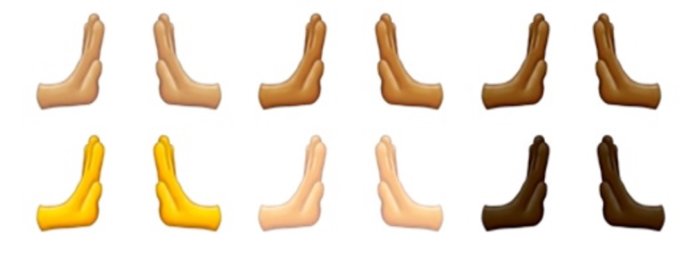
Along with the traditional icons of emojis, technology companies appropriated the word ‘emoji’ to release their branded visualization software foregrounding a more semi-realistic body representation in online communications. In July 2016, Snapchat released Bitmoji [16], an “app that lets users create cartoon avatars that looks [sic!] like themselves.” [17] Samsung released AR Emoji (augmented reality emoji) on March 16, 2018, for users with Galaxy S9 and S9+ smartphones. [18] According to Samsung, “[t]he AR Emojis use deep learning and facial recognition technology to map more than 100 facial features to produce a 3D replica, allowing users to create fun, customized messages.” [19] Apple’s Memoji was released with iOS 12, on September 17, 2018, allowing users “to create an animated avatar of themselves.” [20] Memoji [21] is customizable with users’ “skin color, hairstyle, freckles, glasses, and many other features.” [22] The latest visual trend of this sort is the Meta avatar [23] which was introduced in 2022 with the slogan, “Be Uniquely You.” [24]
Although Bitmoji, Memoji, AR Emoji, and Meta avatars are different from emojis in projecting a more semi-realistic representation of users, they share significant similarities in representing the human body and displaying different ethnicities. They all follow the same path in their visual regime in picturing diversity which is, I argue, a function of neoliberal multiculturalism. Neoliberal multiculturalism as “the signifying systems and cultural repertoires that produce and fix the meaning of human bodies and human groups,” [25] is portrayed in multicultural emojis through two principal codes: color categorization and the Vitruvian Man body template. As a result, multicultural emojis are the visual articulation of the neoliberal discourse whose façade is designed to show diversity but whose core structure advocate for the privilege of the Caucasian body.
3_Neoliberalism and Globalization
Neoliberalism does not value multiculturalism. It instead includes a ‘skin-deep’ and often problematic view of different human identities in its cultural products. This phenomenon, I argue, is the result of the neoliberal urge for ‘propagandistic globalization.’ Neoliberalism has come to mean a variety of economic, social, and political concepts. Moreover, different governments and economic actors shift the appearance of neoliberalism to fulfill their unique cultural and geographical requirements. However, the term and its discourse spin around the same pivot of “how the overall exercise of political power can be modelled on the principles of a market economy.” [26] As a political and economic worldview, neoliberalism facilitates the integration of market-corporate rationale and behavior into all spheres of human life. [27] In Wendy Brown’s words, it is “a governing rationality through which everything is “economized” and in a very specific way: human beings become market actors and nothing but, every field of activity is seen as a market, and every entity (whether public or private, whether person, business, or state) is governed as a firm.” [28]
A key aspect of neoliberalism is globalization. When the market economy becomes the ultimate goal of an idea, the borders should be removed in a purposeful manner so that the circulation of capital reaches its most expansive possible state. According to Brown, “neoliberalism as economic policy, a modality of governance, and an order of reason is at once a global phenomenon.” [29] While the literal meaning of ‘globalization’ is “international integration,” [30] it has been mainly applied to the economic sphere of international relationships as “trade liberalization and the freeing of cross-border financial flows” [31] and “the global free movement of goods, capital and elites.” [32] Noam Chomsky calls this sense the “propagandistic meaning of globalization, which is used and enforced by concentrated power, refers to a very specific form of international integration: one […] which is designed in the interests of private concentrations of power.” [33]
In our neoliberal era, different policies and legal procedures have been accordingly designed to acknowledge global investors and strengthen capital’s power. Along with required legal measures, a “market civilization” emerged, encompassing “cultural mechanisms connected with consumerism, education, leisure activity and the construction of individualist identities.” [34] In fact, the two wings of law and culture enabled globalization to fly freely over borders. Beneath the propagandistic globalization and its subsequent construction of individual identities are layers of problematic and one-dimensional approaches to defining human beings and their identities. That is to say, the neoliberal structure of individual identity is biased with, and based upon, the privilege of a Western worldview.
For one thing, globalization’s primary goal was the promise of better welfare for people of a specific background. As Michel Foucault discusses, globalization is formulated on reaching a limitless enrichment of Europe “as a collective and unlimited enrichment,” according to which “the whole world is summoned around Europe.” [35] It is no surprise, then, that the global “reconfiguration of capitalism” comes along with “the transmission and reproduction of deeply embedded social hierarchies and prejudices rooted in a past characterized by territorial concepts of belonging and notions of civilization that both generated and were generated by racial inequalities.” [36] In other words, although propagandistic globalization symbolically passes across borders, it does not reject or dismiss the old capitalism’s hierarchies and prejudices but wraps them in a new, attractive cover suitable for its time.
4_Neoliberal Multiculturalism
The success of neoliberal globalization of the market depends on its acknowledgment of global agents. Non-European bodies, which were previously considered nonhuman, [37] should now integrate into the spectrum of accepted identities. The ‘controlled’ admission of race and ethnicity, thus, becomes a vital issue. At the heart of globalization are the techniques of the political and economic elite to exploit the developing world’s practices of human agency. Several new governance strategies developed or were revived in the late twentieth century and beyond to fulfill this task. These techniques have generated new administrative domains through which new racialization mechanisms, based on older social divisions and human worth classifications, have been both expanded and regulated. Multiculturalism has been one of those techniques.
Multiculturalism “stands for a wide range of social articulations, ideals and practices.” [38] Nevertheless, all different approaches to multiculturalism collectively “concern the way in which cultural and ethnic differentiation may be accommodated in social, political and economic arrangements.” [39] Multiculturalism can highlight issues such as immigration, support for cultural differences, managing diversity, and adding the spirit of tolerance to the public sphere. [40] Although ‘multiculturalism’ is the characteristic of most societies in that they naturally consist of diverse cultures, propagandist globalization takes this premise a step forward “by making diversity a goal to be furthered by means of state policy.” [41] This is where neoliberal multiculturalism is born.
Neoliberal multiculturalism, along with the expansion of capitalism throughout the world, is also “a name for the signifying systems and cultural repertoires that produce and fix the meaning of human bodies and human groups within the biopolitics produced by neoliberal calculations entering into the governmentality of states and regions.” [42] This sense of neoliberal multiculturalism—classifying diversity based on neoliberal calculations—forms many cultural manifestations, including multicultural emojis. The pursuit of multiculturalism in the neoliberal context has been accredited by claims of ‘neutrality’ between and ‘equality’ among human ethnicities. Nevertheless, the neoliberal formulation of multiculturalism is based on the untold acknowledgment of a dominant race.
5_The Codes
The physicality of the body is a fully digested reality for many of us—we eat, sleep, move, talk, and so on without thinking about these as bodily acts. The function of any body representational regime can be seen as turning these unconscious acts into conscious signs. Those cultural products are efforts to orient the mind and direct the body accordingly. In her expansion upon the concept of the ‘human body,’ Elizabeth Grosz argues,
[b]y body I understand a concrete, material, animate organization of flesh, organs, nerves, muscles, and skeletal structure which are given a unity, cohesiveness, and organization only through their physical and social inscription as the surface and raw materials of an integrated and cohesive totality. The body is, so to speak, organically/biologically/naturally ‘incomplete’; it is indeterminate, amorphous, a series of uncoordinated potentialities which require social triggering, ordering, and long term ‘administration.’ [43]
One way to bring this inevitably broken thing—the body—together is through representational codes. Nevertheless, no representational code is and can be neutral. They cite specific meanings and evoke particular conceptions of the human body. This is why Nicholas Mirzoeff wonders “whether drawing the body, and observing it in art, can produce anything other than monsters of the imagination.” [44] Multicultural emojis are no exception here: they use a range of representational codes to conjure diverse human bodies and identities. Two codes that will be discussed below are color categorization and the Vitruvian Man body template. I will show why these two codes, more than indicating the difference in identities and ethnicities, carry critical concepts that ultimately establish the superiority of the Caucasian body.
6_Color Categorization
The connection between ‘conventional’ colors attributed to different skins and diversity representation is somehow taken for granted in most forms of media representation. Ethnic groups are often defined by, and people are often described as being, specific colors. The idea is seen as natural and neutral. Nonetheless, color categorization can be regarded as part of the neoliberal discourse in acknowledging global actors in which “the particularities of racial bodies are present empirically but often absent analytically.” [45] Classifying people based on color hardly offers any deep understanding of human beings, their history, and their story. It simplifies human ethnicities and traits by amplifying what is ‘empirically’ supposed to be their ‘color.’ Such a view, at its best, is a more carefully articulated version of the Jim Crow system of racial segregation. [46]
Despite the long-unchallenged falsification that “all humans naturally belong to one of a few biological types or races that evolved in isolation,” [47] selecting specific physical characteristics as signifiers of human diversity is a social and historical process. [48] For instance, Donna Zuckerberg suggests that the image of the Greeks as shining examples of whiteness is zealously pushed and, in fact, highjacked by sections of the alt-right who regard themselves as successors to the supposed European warrior masculinity. [49] In the same vein, Tim Whitmarsh proposes that “Greeks simply didn’t think of the world as starkly divided along racial lines into black and white: that’s a strange aberration of the modern, Western world, a product of many different historical forces, but in particular the transatlantic slave trade and the cruder aspects of 19th-century racial theory.” [50] Far from being ‘natural,’ racial categorization revolves around societal power distribution. In the words of Gregory Smithsimon, “[r]ace is a power relationship; racial categories are not about interesting cultural or physical differences, but about putting other people into groups in order to dominate, exploit and attack them.” [51]
This very “modern, western obsession with classification by pigmentation,” [52] regardless of its reactionary and conservative implications, is employed by the Unicode [53] to display ‘diversity’: “Emoji characters can be modified to use one of five different skin tone modifiers. Each tone is based on the Fitzpatrick Scale.” [54] The Fitzpatrick scale was developed by Harvard medical pioneer Thomas B. Fitzpatrick in response to an Australian investigation on skin burning conducted in 1972. Fitzpatrick solely paid attention to the complexion of white Australians, despite the country’s sizable Aboriginal population. Later, categories for skin tones with darker tones were added.
Since the Fitzpatrick scale is a scientific resource, the Unicode Consortium adopted it in its diversity representation. It was a way for them to avoid probable controversial consequences and achieve ‘technological neutrality.’ Nevertheless, it seems that the Fitzpatrick scale is not as neutral as the Unicode desires it to be. The Fitzpatrick scale implies a ‘European-cultural’ centrality even in its sequential steps in representing skins (first, ‘whites,’ then ‘nonwhites’ as additives to ‘fix’ the problem). According to Fitzpatrick himself, the Fitzpatrick scale was created to “better classify persons with white skin in order to select the correct initial doses of ultraviolet.” [55] It was not until later that the representation of other skins was incorporated into the main chart. Similar sequential order can be seen in emojis’ diversity representation: the core, the ‘white,’ was assumed as the default. Later, other ‘colors’ were added to propose a “technical fix” [56] to a problem.
This chronological order has implications in both medical and cultural contexts. For instance, in a dermatological context, reports show that non-Caucasian people struggle to identify with the spectrum of colors provided by this scale. [57] In a cultural context, as Stark and Crawford argue, the employment of the Fitzpatrick scale evokes “hierarchies of gendered and racialized authority and inequality.” [58] Sweeney and Whaley also discuss that “limited representations of non-white identities” and “repeating patterns of racism” shows that “emoji skin-tone modifiers are culturally produced around, and interpreted through, sets of racial logics that extend American technocultural beliefs.” [59] Sweeney and Whaley use “technoculture” to address “the interconnected sets of ideologies that shape technology as both a material and semiotic cultural product.” [60] The Fitzpatrick scale, thus, can reinforce racist ideologies that centralize ‘whiteness’ as the default race: the subconscious vehicle of “white-first/black-last” [61] that reincarnates the “back of the bus” [62] policy.
The relativity and inaccuracy of such scales are more apparent when one considers, perhaps with more attention, the infinite spectrum of skin colors. An exemplary work in this respect is the photo series, Humanæ, by the Brazilian photographer Angélica Dass. Her collection (Fig. 2), which started in 2012, can be seen as a challenge to the mental trend of quickly simplifying human beings as this and that ‘color.’ Dass takes an 11 by 11 pixel cutout from the subject’s face after snapping a picture of them and compares it to a Pantone color. The Pantone shade number is then put to the bottom, and the portrait is positioned on a background of that color. The artist explains her work as a “discussion platform on identity independent from factors such as nationality, origin, economic status, age or aesthetic standards.” [63]
The work is an apparent confrontation with the concept of colored identity. The artist locates the viewer in front of multiple subjects and colors. In one sense, the diversity of colors is much more than what exists based on the media’s stereotypical depiction of ethnicities. The people featured in this collection cannot simply be put in black, brown, or white packages. From an even more meditative perspective, we can see that the color shades of the subjects’ skin is not wholly consistent with the colors extracted from it. This is where the relationship between color and identity becomes further destabilized. Brown, black and white turn into relative myths that, at their best, contain an unstable rule regarding representation. Viewed from this angle, the series can be positioned as contrary to the underlying perception of multicultural emojis that package people and their identities in a limited spectrum of colors.
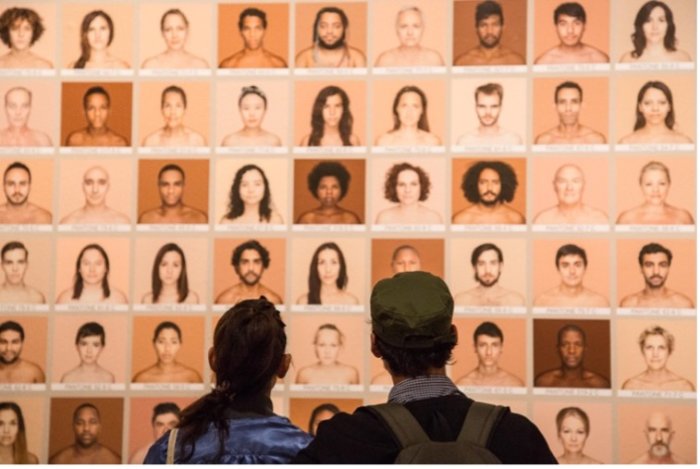
By using the color code, multicultural emojis stand at the intersection of ‘color-blind’ and ‘color-bind’ in formulating the diversity of the human body. Multicultural emojis are an excellent example of how the racially driven mindset of neoliberalism pushes everyone to adhere to their so-called color and simultaneously pretends to create a colorblind world in which racial anxieties play no role. The concept of ‘color-bind’ [65] or ‘color-boundness’ [66] highlights “how people’s identities are imprisoned within the limited spectrum of color categories that have been generated by and distinguished from whiteness.” [67] Color blindness, with the literal meaning of “not influenced by differences of race,” [68] has been seen as a “failure to deal straightforwardly with the pervasive practices of exclusion.” [69] Colorblind rhetoric implies a “false prematurely imagined community” in its “purity,” which is, indeed, “achieved through ignorance.” [70]
Emojis empower color-bind by, on the one hand, creating “cute modes of self-presentation” [71] that attract users and, on the other hand, molding the ‘self’ and ‘identity’ into specific ‘color’ units. One has to find their own pigmentation among different options and represent themselves by that ‘natural’ reference. At the same time, emojis also pretend to be colorblind by putting forward an image of a perfect world—one in which all different colors are holding hands [72]. In colorblind racism, one can observe the declaration that “there are no real problems with racism in our society” and “challenges stem from individuals rather than our institutions and collective thinking and behavior.” [73] In the ideal picture that emojis present, the problem of race is fixed. Coming from a different background is no longer an obstacle; everyone wins! Outside this ‘lovely’ frame, however, the story is different. Emojis’ idealism propagates a perfect image in users’ minds that render racial struggles an expired phenomenon. But this ideal image is based on the monotonous standards of a Western mentality. For example, Western looks become a universal criterion. The natural features of the Caucasian hairstyle as well as style of clothing are imposed on the bodies of other races. In the end, we have an ideal image of a world in which people’s attitudes and appearances do not go beyond the borders of Western Europe and North America.
7_The Vitruvian Man Body Template
The neoliberal pallet of racial colors cannot be applied to any human body template. Its representational strategy requires a template rooted in a tradition of thought that shares the same doctrines and values. Every ‘body template’ is based on a specific conception of human beings and is not, and cannot be, void of a valuation system. Sometimes the projected body challenges the dominating discourse of the ‘harmonical’ or ‘perfect’ body. In other cases, the template conforms to the prevailing model of thought based on reaffirming the superiority of the people of a specific cultural and regional background. I suggest that the body template of multicultural emojis, with a touch of cuteness, follows a traditional western idealism of the human body.
Discussing the iconography of the ‘typical body charts’ of forensic pathology, Joseph Pugliese suggests that “forensic body charts reproduce an unreflexive racism, even as these visual images strive to position themselves as scientifically ‘neutral’, ‘objective’ and ‘universal’.” [74] This ‘typical body template’ is based on Leonardo da Vinci’s Vitruvian Man whose “geometric grid establishes a type of matrix that disciplines the very contours of the human body and determines the normative dimensions and figurations of its features and its surfaces.” [75] Looking at the issue through a Foucauldian lens, it is arguable that such images operate as visual technologies in fulfilling the ‘art of distribution’ of the dominant conceptions. [76]
Many artists, notably the Greek sculptor Polyclitus (480 BC–420 BC.) and the Roman architect Marcus Vitruvius Pollio (80 BC–15 BC.), have done comprehensive studies on the ‘ideal’ human proportions. Their accounts were followed by several attempts to establish a canon of ratios for the human figure during the Middle Ages and Renaissance. Da Vinci began a comprehensive human proportions analysis with enthusiasm and precision during 1489–90. He took several assessments to create a complete correspondence system between all body regions, which he documented in a series of drawings. One of the primary sources for Da Vinci’s anatomical sketches was Vitruvius’s treatise, De architectura. [77] His sketches led to one of his most famous works establishing the ‘ideal’ proportion of the human body, the Vitruvian Man (Fig. 3). In addition to da Vinci, other artists such as Cesare Cesariano (Fig. 4), Geoffroy Tory (Fig. 5), and Heinrich Cornelius Agrippa (Fig. 6) also followed Vitruvius’s De architectura and drew their own Vitruvian Man.
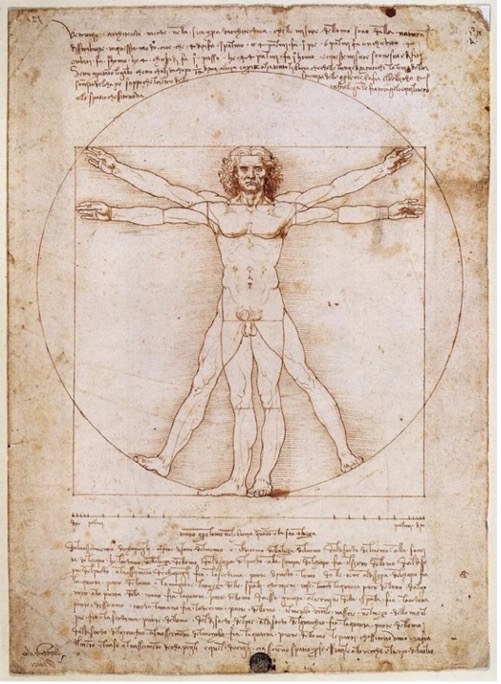
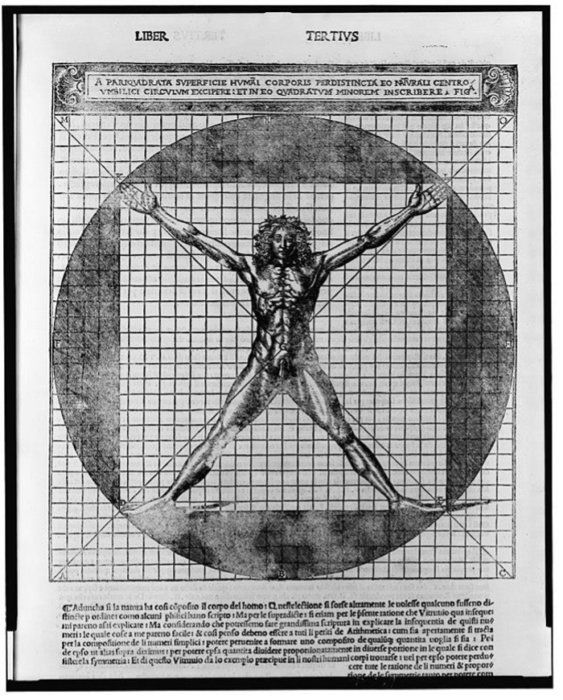
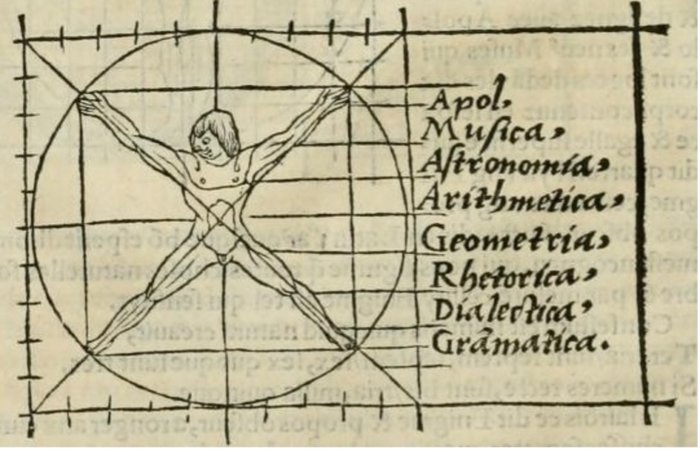
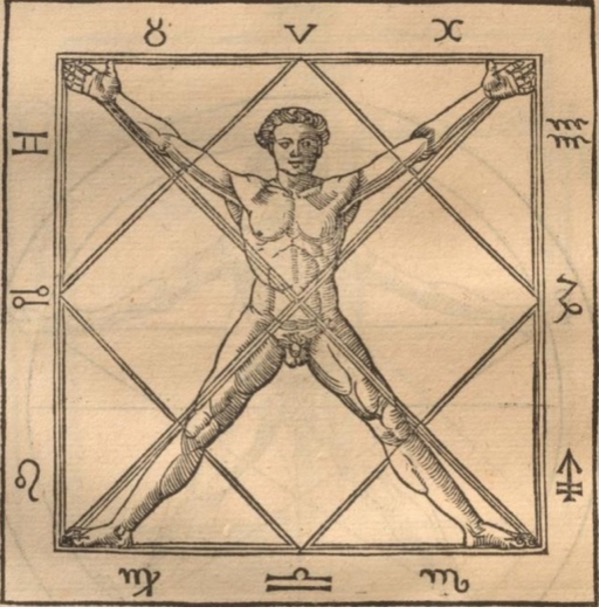
To compare emoji bodies with these Vitruvian Man images, we must remember that emojis are cute images. Cute here refers to something “often, characterized by a big head, the lack of a nose or mouth, and large eyes to show emotion.” [82] Cuteness can also be positioned with “freakishness and the grotesque.” [83] Almost all emoji characters can be considered as cute. Their big heads and large eyes represent them as vulnerable and elicit a tender response in the viewer. Emojis synthesize this cuteness with the sense of ‘symmetrical proportions’ that stem from the Vitruvian Man model. The use of precise proportions to make a symmetrical image has been further facilitated by digital calculations. This fact has led to a meticulously balanced sense of the human body in emojis, both in body parts (eyes, mouth, nose, hands, feet, hair) and the relation of those parts to the body.
Each emoji of the human body can be placed at the center of the Vitruvian Man’s circle and square without disturbing the harmonical ratios of the original image. To examine this proposition, I conducted a simple experiment. As I mentioned above, the face and head of the emojis are the central touch of cuteness in their design. I removed this element. Then I placed images of emoji bodies over the Vitruvian Man body template without changing the emojis’ original ratios. The result can be seen in Fig. 7–10. What we see here indicates that similar proportions work in both sets of images. This, in turn, results in the propagation of a similar symmetrical sense regarding the ‘proper’ proportions of the human body. In a nutshell, the Vitruvian Man model and its balanced proportions are repeated and highlighted, times and again, through the images of emojis.

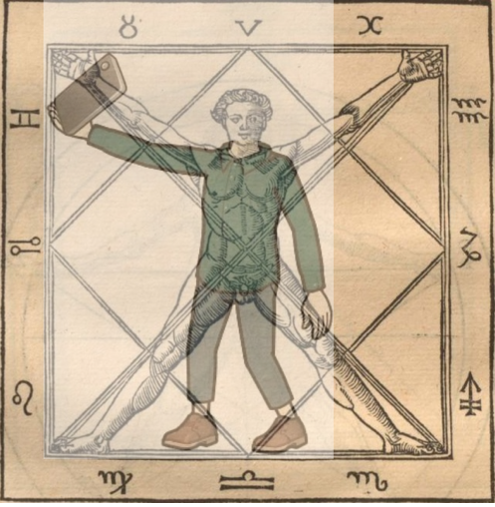
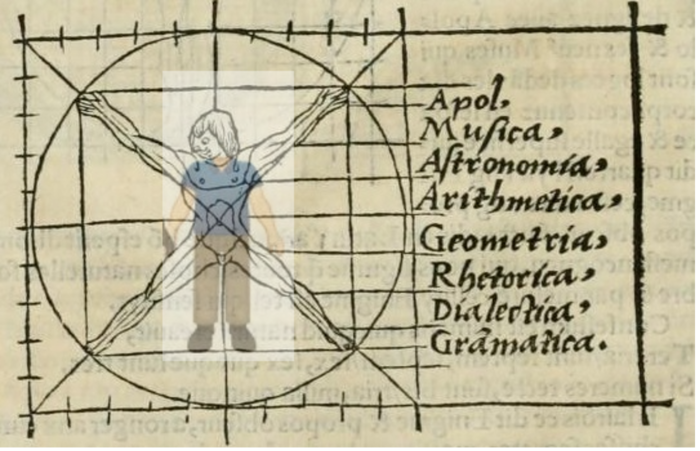
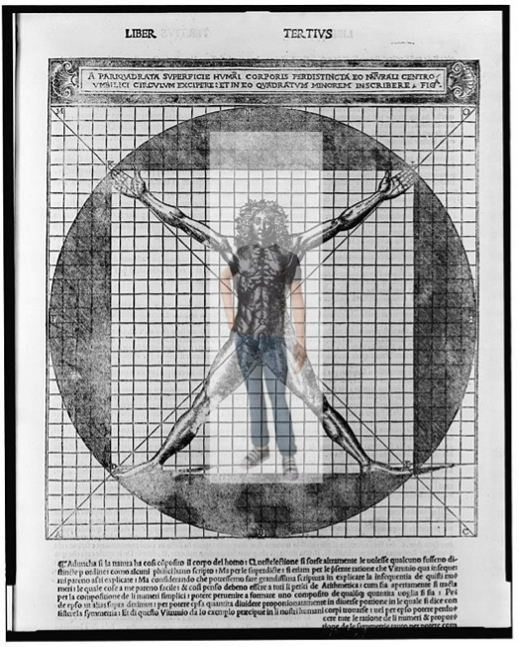
Despite the Vitruvian man’s wide embracement as the depiction of the ‘ideal’ man, one can detect several problematic features embedded in the model. The Vitruvian man and his idealism are not and cannot be universal. Instead, it is “a singular Roman body modelled as universal Man/Human.” [84] The model prompts a colonial “Caucasian body” that “supplies the normative ground against which to measure all other racial ‘deviations.’” [85] Considering ‘blackface’ as a performance of wearing dark makeup in a caricature of the appearance of a person of African origins, multicultural emojis, with a Caucasian body as their backbone, form a silent ‘non-white-face’ performance in the digital context, regardless of their usage. In other words, multicultural emojis paint ‘color’ over a Caucasian male body template and caricature people of different origins.
8_The Goal: The Picture of a Peaceful Inclusion
At first glance, emojis may seem like ‘just’ fun images that are helpful in the context of online communications. However, the way different ethnicities and identities are represented in this collection brings to mind the 20th century solution of Australia and Canada to the ‘aboriginal problem’: the assimilation policy. Since aboriginal people were not considered ‘of full blood,’ they were supposed to be gradually absorbed into the wider population, or to be more precise, the ‘whiter’ population. In the assimilation path, the roots should be forgotten, and the body must appear and act in accordance with the expectations of the dominant society. Over time, this blatant cruelty gave place to a policy suitable for our neoliberal time, which may seem charming at first glance, but its problematic roots remain strong: multiculturalism.
In his contemplation on the definition of neoliberal multiculturalism, Will Kymlicka argues that “the goal of neoliberal multiculturalism is not a tolerant national citizen who is concerned for the disadvantaged in her own society but a cosmopolitan market actor who can compete effectively across state boundaries.” [86] This way of seeing multiculturalism which can be called “democratic social cohesion,” [87] focuses on how individuals interact rather than on their shared ideals or trust relationship. Diversity and difference are not an asset in themselves but should be bridged. The ideal society of this approach to multiculturalism stays limited to the principles of income distribution. Katharyne Mitchell expands upon this sense and suggests that being “a good citizen is no longer synonymous with constituting a well-rounded, nationally oriented, multicultural self, but rather about attainment of the ‘complex skills’ necessary for individual success in the global economy.” [88]
For a neoliberal mindset, ‘money’ is the regulator of everything. Diversity and multiculturalism are not different in that respect. They are welcome as long as they mean something in monetary terms. Thus, neoliberal multiculturalism focuses on not valuing but governing diversity as an effective means of competition in the global market. In Selling Diversity, Yasmeen Abu-Laban and Christina Gabriel argue that
[t]his reading of diversity is also narrow insofar as it fails to problematize structural inequalities that exist between groups of people. In each of the policy areas—immigration, multiculturalism, and employment equity—the focus on economic rationalism has rendered a profoundly narrow vision of diversity, which is basically a selling-out of an agenda on pursuing substantive equality for those marginalized by race/ethnicity, gender, and class. [89]
In the same vein, Kymlicka points out, “[n]eoliberal multiculturalism […] silences debates on economic redistribution, racial inequality, unemployment, economic restructuring, and labor rights.” [90] Multicultural emojis can precisely be comprehended via this way of looking at diversity: an affirmation of commercial linkages and silencing any inequality debate. The presence of ‘colored’ and ‘white’ emojis together gives a view of the perfect world of equality and peacefulness. This image of togetherness functions as a ‘shop-window show’ of color categories, ideal bodies, and racial silence that neither challenges nor allows pondering neoliberalism’s structural premises and promises.
Discussing pornographic photographs, Roland Barthes suggests, “[t]he Photograph is unary when it emphatically transforms ‘reality’ without doubling it, without making it vacillate (emphasis is a power of cohesion): no duality, no indirection, no disturbance […] like a shop window which shows only one illuminated piece of jewelry.” [91] Ashley La Grange adds to this account that “these are banal photographs and are tightly composed.” [92] Whether or not we agree with this account about pornographic photos, the ‘shop window’ argument seems merited regarding multicultural emojis. Are they not images that disturb no profound premise of neoliberalism and ask no real question about or of the—supposedly—represented people? Are they not tightly composed to transform a mainstream reading of diversity without doubling it?
9_Conclusion
Neoliberal racism is a difficult concept to deal with. In terms of appearance, this racism is not in line with the conspicuous historical ones: a group does not capture others with whips and handcuffs and does not force them to put their labor at their service. However, it governs the population by modeling them on patterns that reaffirm white supremacism. In his reflection on neoliberal racism, Joshua Inwood argues that “[o]ne of the things that makes neoliberal racism so difficult to confront is that it takes the overt white supremacy of previous generations and repackages it in a language and context that offer ‘plausible deniability’ to those who profit from it.” [93] This paper viewed multicultural emojis through the same lens: a neoliberal manifestation of diversity that has repackaged white supremacist codes, namely color categorization, and the Vitruvian Man body template. Although those codes are supposed to represent diversity in emojis, they are rooted in a monocultural nature.
There is a general inclination to frame media technologies “as certain vehicles for universal transformation […] as a simple, taken for granted given.” [94] In the words of Thomas Streeter, “creation-from-nowhere assumptions” accompany media technologies and form “structures of understanding that are systematically blind to the collective and historical conditions underlying new ideas, new technologies, and new wealth.” [95] Multicultural emojis are no exception here. As one member of Unicode’s Symbols committee reasons, “[e]mojis are just a set of symbols proposed for encoding and have to be judged as just that.” [96] In the big picture, nothing is just a sign. There is no ‘neutral’ symbol, and any image, sign, and cultural manifestation could always be subject to scrutiny. But even more specifically, concerning emojis, it is the Unicode that deeply desires “universality.” [97] Almost no day goes by without an article about the ‘universality’ of this ‘visual language.’ Thus, it seems entirely justified to investigate how a supposedly universal set of images employ visual codes to manifest their global tendencies.
I adopted a Foucauldian lens to explore how emojis design the ‘universal’ human body and define what it means to be a global subject in our neoliberal time. In the field of emoji literature, this article is a continuation of efforts that analyze the neoliberal layers embedded in emoji images from a discursive perspective. This article undertook the task of unfolding the meanings of two visual codes in multicultural emojis that may seem ordinary and given: color classification and the Vitruvian Man model. Attributing color to identity is one of the remnants of the Atlantic slavery era (ca. 1526–ca. 1867). This trait was later reincarnated in the Jim Crow era (ca. 1877–ca. 1950) of U.S.-American society through laws that enforced adherence to color as a primary factor of identity. By bounding human and ethnic identity to a limited range of colors, emojis call users to a stereotypical understanding and expression of identity.
On the other hand, emojis give an imaginary ideal picture of a world in which colors (ethnicities) are completely accepted and welcome. This way, emojis strengthen the neoliberal rationale based on which the racial struggles are eliminated from macro structures, and whatever challenge is left is up to individual strive. Furthermore, emojis propagate a traditional European sense of human body proportions which rely on the Vitruvian Man as design template for their final images. I examined this proposition by placing the images of emojis over the Vitruvian Man body templates. The results showed that without changing the body ratios of the emojis, they are clearly in harmony with the Vitruvian Man body templates. This manifests that emojis cultivate the same symmetrical sense and ideal proportions boosted by the Vitruvian Man pattern.
To conclude this article, we can think of some further questions. The first question can be asked about identity representation in emojis. Is it possible for a limited number of company representatives or any other group to determine the identity representation of the whole world? Is representing diverse identities in a set of images possible at all? What could be the solution here, if any? Are multicultural emojis the best existing option to represent diversity? Also, we can think about the claims of emojis’ universality: are emojis a set of universal symbols? Which parts of the world are included in this ‘global’ when emojis are considered a universal language? Which human, identity, geographical origin, and culture are we talking about when we call emojis global symbols?
Marcel Danesi argues that “the emoji code might well be the universal language that can help solve problems of comprehension that international communications have always involved in the past.” [98] Even if we take this proposition for granted, we may ask about the nature of the solution that emojis bring forth: do they offer a multicultural solution, or are they a monocultural umbrella arched over all global subjects? And how could their usage yield different from other visual objects in ‘international’ communications? Perhaps, even thinking about seemingly apparent terms like ‘universal,’ we must remind ourselves that we deal with not one but several different ‘universals.’
_How to Cite
Amin Heidari. “Emojis and the Neoliberal Coding of Diversity: A Monocultural Multiculturalism.” On_Culture: The Open Journal for the Study of Culture 14 (2022). <https://doi.org/10.22029/oc.2022.1302>.
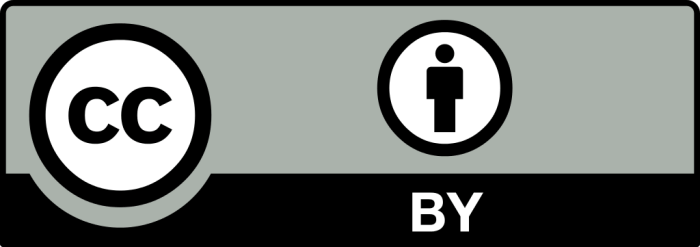
_Endnotes
- [1] The word ‘emoji’ has been used as both singular and plural. I use ‘emoji’ as singular and ‘emojis’ as plural in this article. In cases where an author’s choice differs, I quote them accordingly.
- [2] Luke Stark and Kate Crawford, “The Conservatism of Emoji: Work, Affect, and Communication,” Social Media + Society 1, no. 2 (2015): 1–11, here: 6. Doi: 10.1177/2056305115604.
- [3] Philip Seargeant, The Emoji Revolution: How Technology Is Shaping the Future of Communication (Cambridge: Cambridge University Press, 2019), 178.
- [4] Miriam E. Sweeney and Kelsea Whaley, “Technically White: Emoji Skin-Tone Modifiers as American Technoculture,” First Monday 27, no. 7, (2019). Doi: 10.5210/fm.v24i7.10060.
- [5] Alisa Freedman, “Cultural Literacy in the Empire of Emoji Signs Who Is 😂?,” in Emoticons, Kaomoji, and Emoji: The Transformation of Communication in the Digital Age, eds. Elena Giannoulis and Lukas R. A. Wilde (New York: Routledge, 2020), 44–66, here: 45.
- [6] Gillian Rose, Visual Methodologies: An Introduction to Researching with Visual Materials (London: SAGE, 2016), 188.
- [7] Rose, Visual Methodologies, 41.
- [8] Rose, Visual Methodologies, 41.
- [9] Rose, Visual Methodologies, 192–193.
- [10] See for example Luke Stark’s work on the effects of ‘animation’ form in emojis or Joel Gn’s work on the cuteness of emojis. Luke Stark, “Facial Recognition, Emotion and Race in Animated Social Media,” First Monday 23, no. 9, (2018). Doi: 10.5210/fm.v23i9.9406. Joel Gn, “Emoji as a ‘language’ of Cuteness,” First Monday 23, no. 9, (2018). Doi: 10.5210/fm.v23i9.9396.
- [11] The term emoji is used as an umbrella term hereafter unless otherwise specified.
- [12] “Emoji,” Cambridge Dictionary, accessed May 23, 2022, <https://dictionary.cambridge.org/dictionary/english/emoji>.
- [13] “Japan’s largest telecommunications company: Overview | NTT DOCOMO,” NTT Docomo, accessed May 23, 2022, <https://www.docomo.ne.jp/english/corporate/about/outline/index.html>.
- [14] “world’s first mobile Internet-services platform: History | NTT DOCOMO,” NTT Docomo, accessed May 23, 2022, <https://www.docomo.ne.jp/english/corporate/about/outline/history/>.
- [15] “Emojipedia Sample Images [Updated September 2021],” Emojipedia, <https://emojipedia.org/emojipedia/>.
- [16] You can see some examples at Bitmoji Support, <https://support.bitmoji.com/hc/en-us/articles/360037603511-Mix-and-Match-Outfits>.
- [17] Kif Leswing, “Snapchat Just Introduced a Feature It Paid More than $100 Million For,” in Business Insider, July 19, 2016, <https://www.businessinsider.com/snapchat-just-introduced-a-feature-it-paid-more-than-100-million-for-2016-7>.
- [18] You can see some examples at “‘AR Emoji Can Be a Visual AI Assistant’: Developers on the Galaxy S10 AR Emoji,” Samsung Newsroom, July 15, 2019, <https://news.samsung.com/global/interview-ar-emoji-can-be-a-visual-ai-assistant-developers-on-the-galaxy-s10-ar-emoji>.
- [19] “Samsung and Disney Create AR Emoji Magic for the Galaxy S9 and S9+,” Samsung US Newsroom, March 16, 2018, <https://news.samsung.com/us/samsung-disney-ar-emoji-galaxy-s9-s9plus/>.
- [20] Stephen Silver, “Apple’s IOS 12 Introduces Personalized ‘Memoji’ and Camera Effects,” AppleInsider, June 4, 2018, <https://appleinsider.com/articles/18/06/04/apples-ios-12-introduces-personalized-memoji-and-camera-effects>.
- [21] You can see some examples at “Apple previews iOS 12: Shared AR Experiences, Fun New Ways to Communicate and Screen Time Come to iPhone and iPAd this Fall,” Apple Newsroom, June 4, 2018, <https://www.apple.com/sn/newsroom/2018/06/apple-previews-ios-12>.
- [22] Silver, “Apple’s IOS 12 Introduces Personalized ‘Memoji’ and Camera Effects.”
- [23] You can see some examples at “Introducing the Meta Avatars Store,” Meta, June 20, 2022, <https://about.fb.com/news/2022/06/introducing-the-meta-avatars-store/>.
- [24] “Introducing the Meta Avatars Store,” Meta, June 20, 2022, <https://about.fb.com/news/2022/06/introducing-the-meta-avatars-store/>.
- [25] Jodi Melamed, Represent and Destroy: Rationalizing Violence in the New Racial Capitalism (Minnesota: University of Minnesota Press, 2011), 138.
- [26] Michel Foucault, The Birth of Biopolitics: Lectures at the Collège de France, 1978–1979, eds. Michel Senellart, François Ewald, and Alessandro Fontana, transl. Graham Burchell (London: Palgrave Macmillan, 2008), 131.
- [27] See Rodolfo Leyva, Brains, Media and Politics: Generating Neoliberal Subjects (London: Taylor & Francis, 2019), 11.
- [28] Timothy Shenk, “What Exactly Is Neoliberalism?,” Dissent Magazine (blog), April 2, 2015, <https://www.dissentmagazine.org/blog/booked-3-what-exactly-is-neoliberalism-wendy-brown-undoing-the-demos>.
- [29] Wendy Brown, Undoing the Demos: Neoliberalism’s Stealth Revolution(Cambridge: MIT Press, 2015), 20.
- [30] Noam Chomsky and Jean Drèze, Democracy and Power: The Delhi Lectures (Cambridge: Open Book Publishers, 2014), 120.
- [31] Philip G. Cerny, “Globalization and the Resilience of Neoliberalism,” Critical Policy Studies 8, no. 3 (2014): 359–362, here: 260. Doi: 10.1080/19460171.2014.944370.
- [32] William Davies, The Limits of Neoliberalism: Authority, Sovereignty and the Logic of Competition (London: SAGE, 2014), 113.
- [33] Chomsky and Drèze, Democracy and Power, 120.
- [34] Stephen Gill, “New Constitutionalism, Democratisation and Global Political Economy,” Pacifica Review: Peace, Security & Global Change 10, no. 1 (1998): 23–38, here: 31. Doi: 10.1080/14781159808412845.
- [35] Foucault, The Birth of Biopolitics, 55.
- [36] Deborah A. Thomas and Kamari M. Clarke, “Globalization and Race: Structures of Inequality, New Sovereignties, and Citizenship in a Neoliberal Era,” Annual Review of Anthropology 42, no. 1 (2013): 305–325, here: 306. Doi: 10.1146/annurev-anthro-092412-155515.
- [37] See Rinaldi Walcott, “Afterword: Sentiment or Action,” In Transnationalism, Activism, Art, eds. Kit Dobson and Áine McGlynn (Toronto: University of Toronto Press, 2013), 227–237, here: 233.
- [38] Stuart Hall, “Conclusion: The Multi-Cultural Question,” in Un/Settled Multiculturalisms: Diasporas, Entanglements, Transruptions, ed. Barnor Hesse (London: Zed Books, 2000), 209–241, here: 210.
- [39] Matthew Festenstein, “Cultural Diversity and the Limits of Liberalism,” in Political Theory in Transition, ed. Noël O’Sullivan (London: Routledge, 2000), 70–90, here: 70.
- [40] Augie Fleras, The Politics of Multiculturalism: Multicultural Governance in Comparative Perspective (London: Palgrave Macmillan, 2009), 4.
- [41] John Nagle, Multiculturalism’s Double Bind: Creating Inclusivity, Cosmopolitanism and Difference (Farnham: Ashgate, 2009), 6.
- [42] Melamed, Represent and Destroy, 138.
- [43] Elizabeth Grosz, “Bodies-Cities,” in Places Through the Body, eds. Heidi Nast and Steve Pile (London: Routledge, 2005), 31–38, here: 32.
- [44] Nicholas Mirzoeff, Bodyscape: Art, Modernity and the Ideal Figure(London and New York: Routledge, 1995), 171.
- [45] Thomas and Clarke, “Globalization and Race,” 315.
- [46] For more on Jim Crow segregation system see Ruth Thompson-Miller, Joe R. Feagin, and Leslie H. Picca, Jim Crow’s Legacy: The Lasting Impact of Segregation (Lanham, Maryland: Rowman & Littlefield, 2014).
- [47] Guido Barbujani, “Human Races: Classifying People vs Understanding Diversity,” Current Genomics 6, no. 4 (2005): 215–226, here: 215. Doi: 10.2174/1389202054395973.
- [48] See Michael Omi and Howard Winant, Racial Formation in the United States (New York: Routledge, 2014).
- [49] Donna Zuckerberg, Not All Dead White Men: Classics and Misogyny in the Digital Age(Cambridge: Harvard University Press, 2018).
- [50] Tim Whitmarsh, “When Homer Envisioned Achilles, Did He See a Black Man? | Aeon Essays,” in Aeon, May 9, 2018, <https://aeon.co/essays/when-homer-envisioned-achilles-did-he-see-a-black-man>.
- [51] Gregory Smithsimon, “Race Is Not Real: What You See Is a Power Relationship Made Flesh | Aeon Essays,” in Aeon, March 26, 2018, <https://aeon.co/essays/race-is-not-real-what-you-see-is-a-power-relationship-made-flesh>.
- [52] Whitmarsh, “When Homer Envisioned Achilles, Did He See a Black Man?”
- [53] “UTS #51: Unicode Emoji,” accessed November 10, 2022, <https://www.unicode.org/reports/tr51/tr51-12.html#Diversity>.
- [54] “Emoji Modifier Sequences for Skin Tone,” Emojipedia, accessed May 20, 2022, <https://emojipedia.org/emoji-modifier-sequence/>.
- [55] Thomas B. Fitzpatrick, “The Validity and Practicality of Sun-Reactive Skin Types I Through VI,” Archives of Dermatology 124, no. 6 (1988): 869–871, here: 869. Doi: 10.1001/archderm.1988.01670060015008.
- [56] Kate M. Miltner “‘One Part Politics, One Part Technology, One Part History’: Racial Representation in the Unicode 7.0 Emoji Set,” New Media & Society 23, no. 3 (2021): 515–534, here: 530. Doi: 10.1177/1461444819899623.
- [57] Latrice Pichon et al., “Measuring Skin Cancer Risk in African Americans: Is the Fitzpatrick Skin Type Classification Scale Culturally Sensitive?,” Ethnicity & Disease 20, no. 2 (2010): 174–179.
- [58] Luke Stark and Kate Crawford, “The Conservatism of Emoji: Work, Affect, and Communication,” Social Media + Society 1, no. 2 (2015): 1–11, here: 7. Doi: 10.1177/2056305115604853.
- [59] Sweeney and Whaley, “Technically White.”
- [60] Sweeney and Whaley, “Technically White.”
- [61] Miltner, “‘One Part Politics, One Part Technology, One Part History’,” 527.
- [62] According to Miltner, “‘[b]ack of the bus’ is a reference to the Jim Crow policy of forcing Black riders to sit in the back of the bus, separate from the White riders in the front of the bus.” Miltner, “‘One Part Politics, One Part Technology, One Part History’,” 532.
- [63] Siam Goorwich, “Photographer Takes Pictures of over 2,500 to Prove We’re Not Just Black or White,” Metro (blog), May 12, 2015, <https://metro.co.uk/2015/05/12/photographer-angelica-dass-has-taken-pictures-of-over-2500-people-to-prove-were-not-just-black-or-white-5193085/>.
- [64] LOLAOMI, “Exhibition of Humanae project in Valencia, Spain,” October 22, 2014, CC0, via Wikimedia Commons, <https://commons.wikimedia.org/wiki/File:Ang%C3%A9lica_Dass_retratos.jpg>.
- [65] Jabari Mahiri, Deconstructing Race: Multicultural Education Beyond the Color-Blind (New York: Teachers College Press, 2017).
- [66] Andrea Jonahs, “Colorblind and Colorbound: Everyday Neoliberalism in the Discourses on Romantic Interracial Relationships,” Communication and Critical/Cultural Studies 18, no. 1 (2021): 1–18. Doi: 10.1080/14791420.2020.1854801.
- [67] Mahiri, Deconstructing Race, 29.
- [68] “Definition of COLORBLIND,” Merriam-Webster, accessed May 24, 2022, <https://www.merriam-webster.com/dictionary/colorblind>.
- [69] Patricia J. Williams, Seeing a Colour-Blind Future: The Paradox of Race (London: Virago Press, 1997), 5.
- [70] Williams, Seeing a Colour-Blind Future, 5.
- [71] Simon May, The Power of Cute (Princeton: Princeton University Press, 2019), 11.
- [72] You can find the holding hands emojis on Apple list of emojis provided by Emojipedia.org, at <https://emojipedia.org/apple/show_all/#more>.
- [73] Meghan Burke, Colorblind Racism (Medford, MA: Polity, 2018), 1.
- [74] Joseph Pugliese, “‘Demonstrative Evidence’: A Genealogy of the Racial Iconography of Forensic Art and Illustration,” Law and Critique 15, no. 3 (2004): 287–320, here: 295. Doi: 10.1007/s10978-004-5447-3.
- [75] Pugliese, “‘Demonstrative Evidence’,” 295.
- [76] See Pugliese, “‘Demonstrative Evidence’,” 293–294.
- [77] English translation: On Architecture. Probably written between 30 and 15 BC. See Vitruvius, On Architecture, transl. Richard Schofield (London: Penguin, 2009).
- [78] Leonardo da Vinci, Vitruvian Man, ca. 1492, photograph of image taken by Luc Viatour, Public domain, via Wikimedia Commons,<https://commons.wikimedia.org/wiki/File:Da_Vinci_Vitruve_Luc_Viatour.jpg>.
- [79] Vitruvius Pollio.; Cesariano, Cesare, 1475–1543.; Leonardo, da Vinci, 1452–1519, “A pariquadrata superficie humai corporis perdistincta eo naturali centro umbilici circulum excipere—et in eo quadratum minorem inscribere, fig. a Abstract/medium: 1 print: engraving,” Library of Congress, Public domain, via Wikimedia Commons, <https://commons.wikimedia.org/wiki/File:A_pariquadrata_superficie_humai_corporis_perdistincta_eo_naturali_centro_umbilici_circulum_excipere_-_et_in_eo_quadratum_minorem_inscribere,_fig._a_LCCN2006681079.jpg>.
- [80] Screenshot taken by the author of Geoffroy Tory’s Vitruvian Man. Geoffroy Tory, Champfleury au quel est contenu lart & science de la deue & vraye proportio[n] des lettres attiques, quo dit autreme[n]t lettres antiques, & vulgairement lettres romaines proportionnees selon le corps & visage humain … (est a vendre… par Maistre Geofroy Tory… Et par Giles Gourmont, 1529), <https://www.google.com.au/books/edition/Champfleury_au_quel_est_contenu_lart_sci/OSetEdhivS4C?hl=en&gbpv=0>.
- [81] Screenshot taken by the author of Heinrich Cornelius Agrippa’s Vitruvian Man. Heinrich Cornelius Agrippa von Nettesheim, De occulta philosophia libri tres (Johann Soter, 1533), <https://www.google.com.au/books/edition/De_occulta_philosophia_libri_tres/dVJWAAAAcAAJ?hl=en&gbpv=0>.
- [82] Freedman, “Cultural Literacy in the Empire of Emoji Signs Who Is 😂?,” 54.
- [83] Joshua Paul Dale et al., “The Aesthetics and Affects of Cuteness,” in The Aesthetics and Affects of Cuteness, eds. Joshua Paul Dale et al. (New York: Routledge, 2016), 1–34, here: 4.
- [84] Walter D. Mignolo, “Coloniality Is Far from Over, and So Must Be Decoloniality,” Afterall: A Journal of Art, Context and Enquiry 43 (2017): 38–45, here: 41. Doi: 10.1086/692552.
- [85] Pugliese, “‘Demonstrative Evidence’,” 294.
- [86] Will Kymlicka, “Neoliberal Multiculturalism?,” in Social Resilience in the Neoliberal Era, eds. Michèle Lamont and Peter A. Hall (Cambridge: Cambridge University Press, 2013), 99–126, here: 111. Doi: 10.1017/CBO9781139542425.007.
- [87] Kathy Bickmore, “Democratic Social Cohesion (Assimilation)? Representations of Social Conflict in Canadian Public School Curriculum,” Canadian Journal of Education / Revue Canadienne de l’éducation 29, no. 2 (2006): 359–386. Doi: 10.2307/20054168.
- [88] Katharyne Mitchell, “Educating the National Citizen in Neoliberal Times: From the Multicultural Self to the Strategic Cosmopolitan,” Transactions of the Institute of British Geographers 28, no. 4 (2003): 387–403, here: 399, <https://www.jstor.org/stable/3804388>.
- [89] Yasmeen Abu-Laban and Christina Gabriel, Selling Diversity: Immigration, Multiculturalism, Employment Equity, and Globalization (Toronto: University of Toronto Press, 2002), 173.
- [90] Kymlicka, “Neoliberal Multiculturalism?,” 113.
- [91] Roland Barthes, Camera Lucida: Reflections on Photography (New York: Farrar, Straus and Giroux, 1981), 41.
- [92] Ashley la Grange, Basic Critical Theory for Photographers (London: Taylor & Francis, 2013), 104.
- [93] Joshua Inwood, “Neoliberal Racism: The ‘Southern Strategy’ and the Expanding Geographies of White Supremacy,” Social & Cultural Geography 16 (2015): 1–17. Doi: 10.1080/14649365.2014.994670.
- [94] Anita Say Chan, Networking Peripheries: Technological Futures and the Myth of Digital Universalism, (Cambridge, Mass: MIT Press Academic, 2014), 5.
- [95] Thomas Streeter, The Net Effect: Romanticism, Capitalism, and the Internet (New York: NYU Press, 2010), 12.
- [96] Miltner, “‘One Part Politics, One Part Technology, One Part History’,” 522.
- [97] Miltner, “‘One Part Politics, One Part Technology, One Part History’,” 522.
- [98] Marcel Danesi, The Semiotics of Emoji: The Rise of Visual Language in the Age of the Internet (London: Bloomsbury Publishing, 2017), vii.


